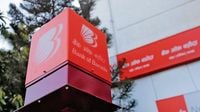Shares of Bank of Baroda (BoB) experienced a significant drop on May 6, 2025, plummeting nearly 10% to ₹224.21 on the National Stock Exchange (NSE) following the announcement of its quarterly earnings. Despite reporting a 3.3% year-on-year increase in net profit to ₹5,048 crore for the fourth quarter of FY25, the bank's performance fell short of investor expectations, primarily due to a decline in net interest income (NII) and rising asset quality concerns.
In its earnings report, the bank revealed that net interest income had decreased by 6.6% year-on-year to ₹11,020 crore, a figure that was lower than analysts' expectations of ₹11,678 crore. This disappointing result, coupled with a rise in gross slippages—recorded at ₹3,159 crore compared to ₹2,915 crore in the previous quarter—cast a shadow over the positive net profit figure.
Bank of Baroda's gross non-performing assets (NPA) stood at 2.26%, down from 2.43% quarter-on-quarter, while net NPA was reported at 0.58%, slightly improved from 0.59% QoQ. The bank's provision coverage ratio remained robust at 93.29% as of March 31, 2025, reflecting its commitment to maintaining a strong asset quality.
In terms of dividends, the bank's board recommended a payout of ₹8.35 per equity share for FY25, marking the highest dividend announced since the stock split. This recommendation is subject to approval at the upcoming 29th Annual General Meeting, with a record date set for June 6, 2025, for eligible shareholders.
For the entire financial year 2024-25, Bank of Baroda reported a 10% increase in profit, totaling ₹19,581 crore, up from ₹17,789 crore the previous year. The bank's total income also saw a rise, reaching ₹1,38,089 crore compared to ₹1,27,101 crore in the prior year. Interest income for the fourth quarter increased to ₹30,642 crore from ₹29,583 crore year-on-year.
Despite these gains, the market reacted negatively to the earnings report, with analysts suggesting that the decline in NII and the increase in bad loans overshadowed the positive aspects of the net profit growth. Anshul Jain, Head of Research at Lakshmishree Investments, noted that the stock's rejection of a key resistance level indicated potential further downside pressure, with immediate targets set at lower levels if the stock fails to recover.
Bank of Baroda's global business has surpassed ₹27 lakh crore as of March 31, 2025, with a credit cost remaining below 1% at 0.47% for FY25. The bank's global advances registered a growth of 12.8% year-on-year, while domestic advances grew by 13.7%, driven by a robust expansion in its retail loan book. CASA (current account and savings account) deposits also increased by 6.4% year-on-year, totaling ₹4,96,462 crore as of March 31, 2025.
The bank's capital adequacy ratio improved to 17.19%, up from 16.31% at the end of FY24, further demonstrating its solid financial standing. However, the decline in net interest income and the rise in slippages remain key concerns for investors and analysts alike.
As the market continues to digest these results, Bank of Baroda's performance will be closely monitored in the coming quarters. Investors are keenly aware of the bank's ability to navigate the challenges presented by fluctuating asset quality and interest income, which will be crucial for sustaining growth and shareholder confidence in the future.
Overall, while Bank of Baroda's net profit figures reflect a positive trend, the underlying challenges highlighted in the earnings report underscore the complexities of the current banking landscape. The upcoming months will be critical for the bank as it seeks to stabilize its share price and reassure investors of its long-term viability.


